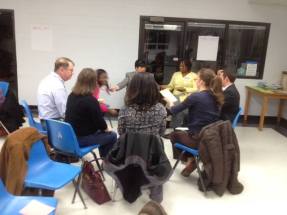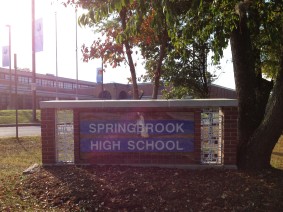
Last Thursday, approximately 40 activist parents and residents came together for One Montgomery’s first community workshop at the Episcopal Church of the Transfiguration in Colesville. Reporters from the student and professional press were there as well.

Following time for initial greetings, the interrelated issues of residential and school socio-economic segregation, underfunding of schools with concentrated poverty and school academic underperformance were presented through PowerPoint pictures, words and graphs.
Workshop participants separated into groups to discuss and later present the strengths and weakness and opportunities and threats characterizing our schools; and the causes of and solutions for our current situation. The groups’ findings are outlined below.
The meeting concluded with observations regarding the political nature of school improvement. Change will require formation of an active community and its insistent communication of the request for change.
What are our schools’ present strengths and weaknesses?
Strengths
1. New facilities
2. Every school has honors and AP programs
3. Strong principals at individual schools (e.g., Blair and Springbrook)
4. Some strong PTAs engaging parents with cultural barriers
5. Diversity
Weaknesses
1. Politics for resource distribution
2. Weak community engagement
3. Wide gap in scores across individual schools
4. Cultural misconceptions of students within school (e.g., withheld opportunities, more minorities with suspensions)
5. Public perception that schools are bad – middle class flight
What opportunities and threats do our schools face in the future?
Opportunities
1. Increase SAT scores and graduation rates
2. Strong leadership: Maryland-school-community
3. Safety—a priority
4. Maintenance of effort—increase base funding
5. Reputation of success of school
6. Better branding
7. Good social interaction
8. More libraries/music programs: allow leadership opportunities for students
9. Head Start/Pre-K
10 Build on diversity for global citizens
11. Language, tech
Threats
1. More violence
2. People move out of neighborhoods
3. Economic vulnerability
4. Imbalance – population growth
5. Continuing low level of involvement by parents
6. Perception and reality of inequalities
7. Can’t increase enrollment without parent involvement
8. Middle schools lose ability to meet student needs
9. Bad branding – identify issues and make adjustments
What are the causes of current issues in our schools?
1. Economic disparities
a. Demographic changes to economy
b. Consortium maintains economic status quo
c. Correlation between race proportions and economic opportunity
2. Cultural differences
a. Not understanding differences in students, unique needs
b. Staff cultural competency
3. Continual staff training; necessary supports
4. Standardized testing teaching vs. engagement in learning
5. Home life
a. Lack of wrap around service
b. Lack of early childhood education
c. Lack of resources to support and advocate
What are some possible solutions for improving our schools?
1. Greater access for Head-Start: advocate for funds
2. Advocate for resources from Annapolis for our County
3. Volunteer program from qualified high school students, local colleges/universities
4. Solutions aren’t necessarily easy
5. Alternative programs for students with behavior problems
6. Stop changing the curriculum
7. Formula needs to match needs of the school; fair does not mean equal
8. Candid communication between MCPS and community
9. Greater resources for high needs schools
10. Proactive with population trends
Group Members
| Strengths,Weaknesses | Opportunities,Threats | Causes | Solutions | |
| Facilitator | Debbie | Ed | All | Ralph |
| Scribe | Stephanie | Stephanie | Dee | Evelyn |
| Time keeper | Thalia | Jewru | Rosina | Lulu |
| Presenter | Bernice | Core | Jay | Jill |
| Members | Dan David TeddySharon Fred Kyle | Otto BobAdrienne | Josh Evan AdamDiana Neal | Mark, Ann |
 In anticipation of
In anticipation of 